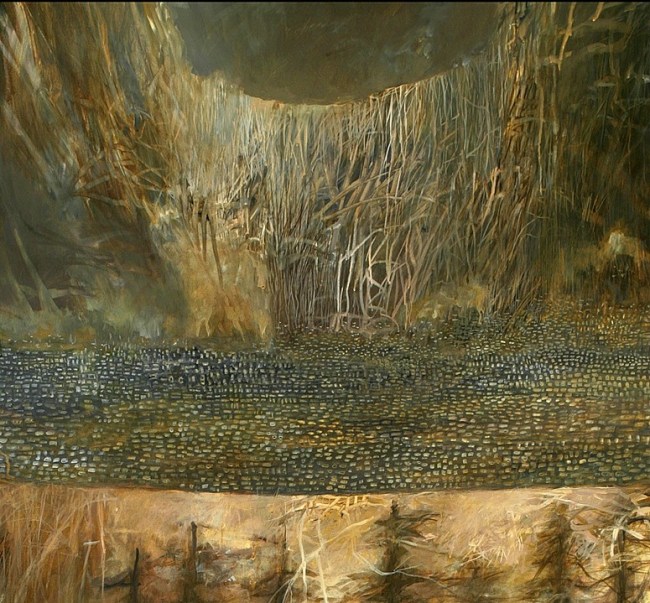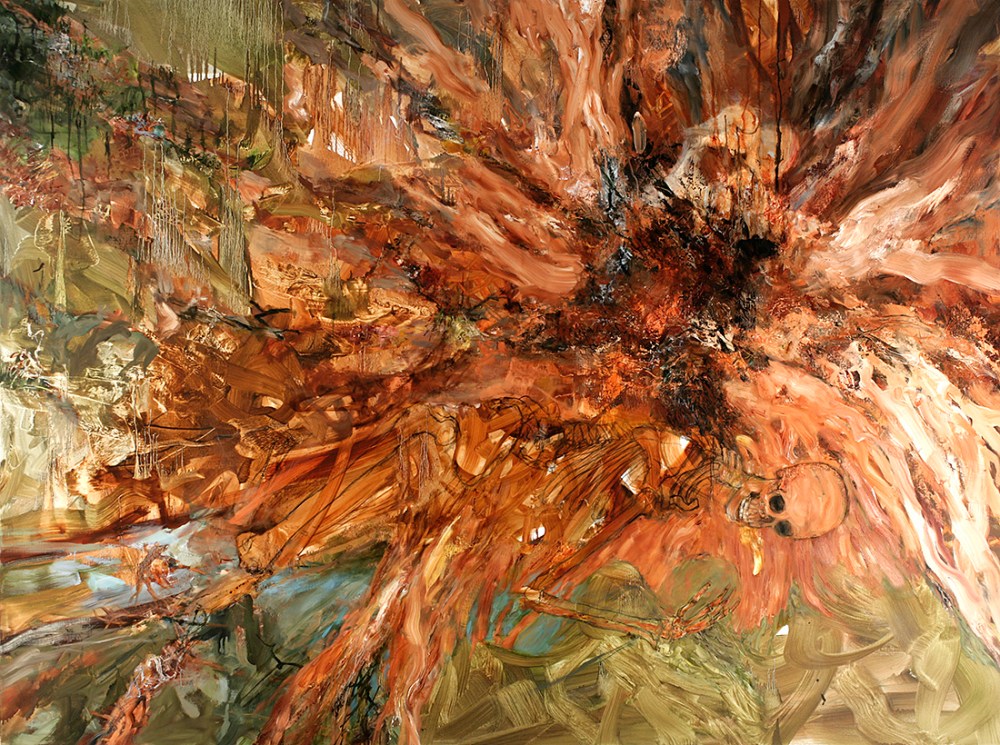By Etty Yaniv
Throughout her highly imaginative multidisciplinary projects, Jessica Segall has been engaging with a wide range of fragile ecological sites, frequently with animals as her collaborators – for instance, swimming with tigers and sculpting with live bees. In this interview, Segall shares some of her work and thought processes, and talks about her upcoming projects.
You are a multidisciplinary artist using a diverse range of media, some most unconventional – lemons, refrigerators, tigers. How do you choose your media? Can you give me a couple of examples?
The media in each work is chosen for its utility or ability to best answer a proposition. There also has to be a transformation. Usually one of the material questions is: Will this work? Sometimes half of the proposition hangs in the air for a while until I find its material counterpoint. Fugue in B Flat started that way, as a material prompt and then a proposal before it became a sculpture. I had always wanted to work with the free pianos available off of Craigslist – its an unusually available material in our time and place. Pianos once had high enough value in craftsmanship and social meaning that families would pay to have them hauled up flights of stairs. But today, an inherited piano is not worth enough to sell, or pay to have removed, so every day there are new pianos available for free in New York City.
Years later, when I was learning to keep bees, the piano resurfaced. Bees are the last animals we colonized into livestock. In more primitive beekeeping methods, bees formed their own hive structures in skeps, or baskets. But to more efficiently extract the honey without harming bees, the idea of “bee space†was utilized, which determines the size of beehive boxes and frame proximity. While the interior architecture of the beehive is laid out within 3/8 of an inch, the superstructure of a beehive could be anything, which led me to consider the piano as a potential hive, considering the available space in between the soundboard and harp.
There are other reasons to work with pianos and bees of course – I play music, studied Anthroposophy and am invested in ecological futures. But practically, the material has to perform.



In your site-specific work, you seem to be drawn to vulnerable ecological sites. Can you talk a bit on what draws you there?
Yes, the sites I chose to work in have great ecological vulnerability, or speak to human vulnerability. They deal with both the human and geological timescales. The Arctic is a timeless space, a geological era before and after human life on earth. Placing the Global Seed Vault on Svalbard was a way of safekeeping our genetic future, but even there, the permafrost is unreliable, in a big part from our own making. I treated my visit to the agricultural basin of California as disaster tourism – the almond blooms in my photos are often confused for the cherry blossom in Japan. But that beauty is monoculture relying on the major efforts of on-demand water and pollination services. In a way, these are all economic landscapes, shaped by human consumption.
What do you think brought you to art?
Honestly, I was too young to remember! My first painting was on my grandfather’s easel. My family introduced me to art culture and activism from a young age. Growing up, I had a great-uncle who made kinetic Dada sculptures, and my cousin was a performance artist in the East Village in the 90s. Both my parents wrote books. Luckily there was a public arts school where I grew up so I’ve been focused on art for a long time.
I was attracted to the radical criticality of art. Its queer culture and discourse. I never imagined how much time I would spend writing grant proposals.
Tell me about “Nom Nom Ohm,†your installation from 2016. In the list of material I found fruits, root vegetables, and rewired chandeliers.
“Nom Nom Ohm†is in a vein of work examining alternative power sources and degrowth. It is also a modern day vanitas. They are chandeliers that are rewired to be powered by fruits and vegetables. I liked the idea of the chandeliers in the marketplace, powered by the fruits sold there and proposed this work to Cuchifritos in The Essex Market in New York City. The market was about to be relocated and this work was something of a visual for the transition from this long-standing neighborhood market into high rise luxury apartments.

What can you tell me about your 2018 two-channel video installation “Un-common Intimacy†described on your website as “Performance swimming with predators at private wildlife parks in the United States.â€
“Un-common Intimacy†was shot in private wildlife reserves in the six US states that allow private ownership of large predators. Today, there are more tigers in captivity than in the wild; strange colonial ecosystems that rely on private property but also voluntary guardians in service to a nexus of entertainment and conservation economies. That’s the setting. What you see in the video work is more of a blank slate as its filmed entirely underwater. I’m swimming with tigers and alligators, capturing the potential intimacies under these conditions.

Performance seems to be a constant in your work. In 2009, you had a performance called Tourist Crisis Center in collaboration with Tourist Artist Collective. I am curious to know more about that.
This was a project in collaboration with several other artists I studied with at Bard College – Anne Cleary, Jess Perlitz, Brigid McCaffrey and Jane Parrot. We were invited, via friend and poet Arlo Haskell, to The Studios of Key West to make a public work. Somehow we resolved to build an offshore public office for tourists in crisis. Symptoms included fugue states, and other crises one experiences when shifting from worker to full-time consumer. We built an office on dock floats, complete with a fax machine, a telephone, office plants and a rolling chair, while Arlo pulled us around the island with his boat, dropping us off at key points for public interface. We took turns manning the office, while dressed in our secretarial finest. Some of us helped tourists write letters home. Key West is the kind of unbelievable community that only gathers in the farthest reaches of land masses. We were stopped by the Coast Guard at one point by a concerned caller phoning in “a lady being dragged on a desk.†We were also stopped by border patrol as we tried to swim from our desk to shore, in the logic that we were a ruse for illegal immigration. That was in 2009. I can’t imagine what the politic would be today.

Where do you think your work is heading now?
On the horizon is a mix of studio work in Brooklyn and opening up my practice to coordinating public events and activism. I am co-organizing a lecture series at my studio in Brooklyn on economy, ecology, and trust, along with other ways of seeing our environment – through queer ecologies and animism. There are several long term projects I’m working on strategizing land art as land conservation; methods to counteract increasing privatization of federal land, and the militarization of our borders.
In the studio I will be working on new multi-species sculptures and a video work making parallels between climate change and BDSM. I will be traveling a bit for site-specific work in Finland, France, and Columbia while keeping a studio base in Brooklyn.
(Top image: Un-common intimacy, video still, 2018. All photos courtesy of the artist unless otherwise indicated.)
This interview is part of a content collaboration between Art Spiel and Artists & Climate Change. It was originally published on Art Spiel on April 10, 2019 as part of an ongoing interview series with contemporary artists.
______________________________
Etty Yaniv works on her art, art writing, and curatorial projects in Brooklyn. She has exhibited her immersive installations in museums and galleries, nationally and internationally. Yaniv founded the platform Art Spiel to highlight the work of contemporary artists through art reviews, studio visits, and interviews with artists, curators, and gallerists. Yaniv holds a BA in Psychology and English Literature from Tel Aviv University, a BFA from Parsons School of Design, and an MFA from SUNY Purchase.
———-
Artists and Climate Change is a blog that tracks artistic responses from all disciplines to the problem of climate change. It is both a study about what is being done, and a resource for anyone interested in the subject. Art has the power to reframe the conversation about our environmental crisis so it is inclusive, constructive, and conducive to action. Art can, and should, shape our values and behavior so we are better equipped to face the formidable challenge in front of us.
Go to the Artists and Climate Change Blog
Powered by WPeMatico








































